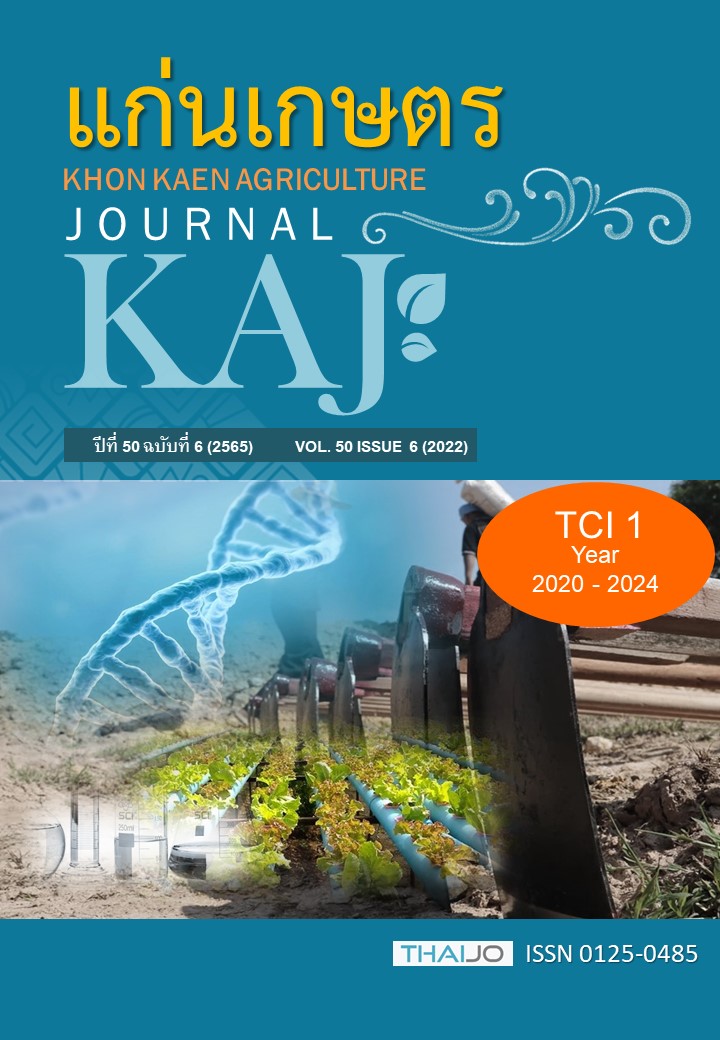ชีวภัณฑ์ทางเลือกของสารเคมีกำจัดแมลงศัตรูพืชในโรงเรือนเมล่อน
Main Article Content
บทคัดย่อ
เมล่อนเป็นพืชเศรษฐกิจมูลค่าสูงของไทย การควบคุมแบบชีววิธีโดยใช้จุลินทรีย์ เป็นอีกแนวทางหนึ่งของการจัดการศัตรูพืชเพื่อรองรับตลาดเกษตรอินทรีย์และเกษตรปลอดภัยรวมไปถึงตลาดการส่งออก ดังนั้นงานวิจัยนี้จึงเป็นการศึกษาประสิทธิภาพของการใช้ชีวภัณฑ์ราบิวเวอเรีย Beauveria bassiana BCC 2660 ราเมตาไรเซียม Metarhizium sp. BCC 4849 และราไตรโคเดอร์มา Trichoderma asperellum TBRC 4734 เพื่อจัดการแมลงศัตรูพืชและโรคพืชในเมล่อนภายใต้สภาพโรงเรือน โดยเปรียบเทียบประสิทธิภาพกับการใช้สารเคมี รวมถึงตรวจสอบการตกค้างของสารเคมี Clothianidin ในผลเมล่อนสดและดิน จากการทดสอบพบแมลงศัตรูเมล่อน 3 ชนิด คือ ไรแดง (Eutetranychus africanus) แมลงหวี่ขาวยาสูบ (Bemisia tabaci) และเพลี้ยไฟเมล่อน (Thrips palmi) ข้อมูลจำนวนประชากรแมลงจากการตรวจนับโดยตรงใต้ใบเมล่อนพบว่า ประชากรแมลงศัตรูเมล่อนทั้งสามข้างต้นในกรรมวิธีชีวภัณฑ์อย่างเดียว ลดลงไป 34.8, 0.3, 18.7% และ 66, 0.3, 8.9% เมื่อเทียบกับกรรมวิธีชีวภัณฑ์ร่วมกับสารเคมี และกรรมวิธีสารเคมีอย่างเดียว ตามลำดับ สำหรับการตรวจสอบแมลงบนกับดักกาวเหนียว พบแมลงศัตรูเมล่อน 2 ชนิด คือ แมลงหวี่ขาวยาสูบ และเพลี้ยไฟเมล่อน โดยกรรมวิธีชีวภัณฑ์อย่างเดียวมีจำนวนแมลงศัตรูเมล่อนลดลงไป 6.5, 17.7% และ 7.3, 21.5% เทียบกับกรรมวิธีชีวภัณฑ์ร่วมกับสารเคมี และกรรมวิธีสารเคมีอย่างเดียว ตามลำดับ นอกจากนี้ยังพบว่าชีวภัณฑ์สามารถส่งเสริมให้อินทรียวัตถุในดินสูงถึง 15% ซึ่งส่งผลต่อการเพิ่มปริมาณของธาตุอาหารที่เป็นประโยชน์แก่พืชมากขึ้น เมื่อตรวจสอบการตกค้างพบว่ามีสารเคมี Clothianidin ตกค้างในผลเมล่อนสด 0.023 มก./กก. และตกค้างในดินสูงที่สุด 1.607 มก./กก. ในกรรมวิธีที่ฉีดพ่นด้วยสารเคมี โดยพบการตกค้างเพียงเล็กน้อยในกรรมวิธีชีวภัณฑ์ร่วมกับสารเคมี (ผลสด 0.0008 มก./กก. และ 0.258 มก./กก. ในดิน) และไม่พบการตกค้างในแปลงที่ใช้ชีวภัณฑ์ ผลที่ได้แสดงให้เห็นว่าสามารถใช้ชีวภัณฑ์ทดแทนสารเคมีในการจัดการศัตรูพืชเมล่อนในสภาพโรงเรือนได้อย่างมีประสิทธิภาพ ผลที่ได้นี้แสดงถึงชีวภัณฑ์สามารถใช้เป็นทางเลือกของสารเคมี และมีศักยภาพในการจัดการศัตรูพืชสำหรับเกษตรอินทรีย์และเกษตรปลอดภัย
Article Details

อนุญาตภายใต้เงื่อนไข Creative Commons Attribution-NonCommercial-NoDerivatives 4.0 International License.
เอกสารอ้างอิง
นาวิน สุขเลิศ, จิราพร กุลสาริน, ไสวบรูณพานิชพันธุ์ และวีรเทพ พงษ์ประเสริฐ. 2559. ประสิทธิภาพของสารชีวภัณฑ์เชื้อรากำจัดแมลงในการควบคุมด้วงหมัดผักแถบลายในเบบี้ฮ่องเต้บนพื้นที่สูงของจังหวัดเชียงใหม่. วารสารเกษตร. 32(2): 171-180.
วัฒนา จารณศรี, มานิตา คงชื่นสิน, เทวิน กุลปิยะวัฒน์ และพิเชฐ เชาวน์วัฒนวงศ์. 2544. ไรศัตรูพืชและการป้องกันกำจัด. กรมวิชาการเกษตร กองกีฏและสัตววิทยา กลุ่มงานวิจัยไรและแมงมุม. กรุงเทพฯ.
อลงกรณ์ อำนวยกาญจนสิน, รัศมี หวะสุวรรณ, เชษฐ์ธิดา ศรีสุขสาม, ธงชัย ตั้งใจดี, กัลยารัตน์ รัตนะจิตร, เสาวนีย์ ปานประเสริฐกุล,ยุวนันท์ สันติทวีฤกษ์, กฤษดา บำรุงวงศ์, สุชาดา มงคลสัมฤทธิ์, เจนนิเฟอร์ เหลืองสะอาด และมรกต ตันติเจริญ. 2564. ภาพลักษณ์ของราแมลงและการใช้ประโยชน์ในสังคมไทย. วารสารมนุษยศาสตร์ปริทรรศน์. 43(1): 111-123.
Abdallah, O.I., R.M. Abd El-Hamid, and E.H. Abdel Raheem. 2019. Clothianidin Residues in Green Bean, Pepper and Watermelon Crops and Dietary Exposure Evaluation Based on Dispersive Liquid-Liquid Microextraction and Lc–Ms/Ms. Journal of Consumer Protection and Food Safety. 14(3): 293-300.
Aktar, M.W., D. Sengupta, and A. Chowdhury. 2009. Impact of Pesticides Use in Agriculture: Their Benefits and Hazards. Interdisciplinary toxicology. 2(1): 1-12.
Akutse, K.S., F.M. Khamis, F.C. Ambele, J.W. Kimemia, S. Ekesi, and S. Subramanian. 2020. Combining Insect Pathogenic Fungi and a Pheromone Trap for Sustainable Management of the Fall Armyworm, Spodoptera Frugiperda (Lepidoptera: Noctuidae). Journal of Invertebrate Pathology. 177: 107477.
Al-mazra'awi, M., A. Al-Abbadi, M. Shatnawi, and M. Ateyyat. 2009. Effect of Application Method on the Interaction between Beauveria Bassiana and Neem Tree Extract When Combined for Thrips Tabaci (Thysanoptera: Thripidae) Control. Journal of Food Agriculture and Environment. 7: 869-873.
Amnuaykanjanasin, A., J. Jirakkakul, C. Panyasiri, P. Panyarakkit, P. Nounurai, D. Chantasingh, and M. Tanticharoen. 2013. Infection and colonization of tissues of the aphid Myzus persicae and cassava mealybug Phenacoccus manihoti by the fungus Beauveria bassiana. Journal of the International Organization for Biological Control. 58(3): 379-391.
Benítez, T., A.M. Rincón, M.C. Limón, and A.C. Codón. 2004. Biocontrol mechanisms of Trichoderma strains. International microbiology: the official journal of the Spanish Society for Microbiology. 7(4): 249-260.
Birkhofer, K., T.M. Bezemer, J. Bloem, M. Bonkowski, S. Christensen, D. Dubois, and S. Scheu. 2008. Long-term organic farming fosters below and aboveground biota: Implications for soil quality, biological control and productivity. Soil Biology and Biochemistry. 40(9): 2297-2308.
Bommuraj, V., Y. Chen, H. Klein, R. Sperling, S. Barel, and J.A. Shimshoni. 2019. Pesticide and trace element residues in honey and beeswax combs from Israel in association with human risk assessment and honey adulteration. Food Chemistry. 299: 125123.
Bonmatin, J.M., I. Moineau, R. Charvet, C. Fleche, M.E. Colin, and E.R. Bengsch. 2003. A LC/APCI-MS/MS Method for Analysis of Imidacloprid in Soils, in Plants, and in Pollens. Analytical Chemistry. 75(9): 2027-2033.
Bray, R.H., and L.T. Kurtz. 1945. Determination of Total Organic and Available Forms of Phosphorus in Soils. Soil Science. 59(1): 39-46.
Carter, M.R., and E.G. Gregorich. 2008. Soil sampling and methods of analysis. European Journal of Soil Science. 59(5): 1010-1011.
Castineiras, A., J.E. Peña, R. Duncan, and L. Osborne. 1996. Potential of Beauveria Bassiana and Paecilomyces Fumosoroseus (Deuteromycotina: Hyphomycetes) as Biological Control Agents of Thrips Palmi (Thysanoptera: Thripidae). The Florida Entomologist. 79(3): 458-461.
Hano, T., K. Ito, N. Ohkubo, H. Sakaji, A. Watanabe, K. Takashima, and K. Mochida. 2019. Occurrence of neonicotinoids and fipronil in estuaries and their potential risks to aquatic invertebrates. Environmental Pollution. 252: 205-215.
Harman, G.E., C.R. Howell, A. Viterbo, I. Chet, and M. Lorito. 2004. Trichoderma species - opportunistic, avirulent plant symbionts. Nature Reviews Microbiology. 2(1): 43-56.
Mahmood, I., S.R. Imadi, K. Shazadi, A. Gul, and K.R. Hakeem. 2016. Effects of Pesticides on Environment. Plant Soil and Microbes. 1: 253-269.
Palumbo, J.C., and D. Kerns. 1998. Melon Insect Pest Management in Arizona. University of Arizona, College of Agriculture and Life Sciences. IPM Series. 11: 1-7.
Rebecca B., United States. Natural Resources Conservation Service., National Soil Survey Center (U.S.)., and National Soil Survey Laboratory (U.S.). 2004. Soil survey laboratory methods manual. United States Dept. of Agriculture, Natural Resources Conservation Service. Washington, D.C.
Tabara, M., Y. Nagashima, K. He, X. Qian, K.M. Crosby, J. Jifon, G.K. Jayaprakasha, B. Patil, H. Koiwa, H. Takahashi, and T. Fukuhara. 2021. Frequent asymptomatic infection with tobacco ringspot virus on melon fruit. Virus research. 293: 198266.
Walkley, A., and I.A. Black. 1934. An Examination of the Degtjareff Method for Determining Soil Organic Matter, and a Proposed Modification of the Chromic Acid Titration Method. Soil Science. 37(1): 29-38.
Wang, A., G. Mahai, Y. Wan, Y. Jiang, Q. Meng, W. Xia, and S. Xu. 2019. Neonicotinoids and carbendazim in indoor dust from three cities in China: Spatial and temporal variations. Science of The Total Environment. 695: 133790.
Wang, X., L. Xue, S. Chang, X. He, T. Fan, J. Wu, J. Niu, and B. Emaneghemi. 2019. Bioremediation and Metabolism of Clothianidin by Mixed Bacterial Consortia Enriched from Contaminated Soils in Chinese Greenhouse. Process Biochemistry. 78: 114-122.
Wasuwan, R., N. Phosrithong, B. Promdonkoy, D. Sangsrakru, C. Sonthirod, S. Tangphatsornruang, S. Likhitrattanapisal, S. Ingsriswang, C. Srisuksam, K. Klamchao, M. Suksangpanomrung, T. Hleepongpanich, S. Reungpatthanaphong, M. Tanticharoen., and A. Amnuaykanjanasin. 2022. The Fungus Metarhizium Sp. Bcc 4849 Is an Effective and Safe Mycoinsecticide for the Management of Spider Mites and Other Insect Pests. Insects. 13(1): 42.
Zhang, Q., C. Shan, W. Song, W. Cai, F. Zhou, M. Ning, and F. Tang. 2021. Transcriptome Analysis of Starch and Sucrose Metabolism Change in Gold Queen Hami Melons under Different Storage Temperatures. Postharvest Biology and Technology. 174: 111445.
Zimmermann, G. 1993. The entomopathogenicf ungus Metarhizium anisopliaeand its potential as a biocontrol agent. PesticideScience. 37(4): 375-379.


